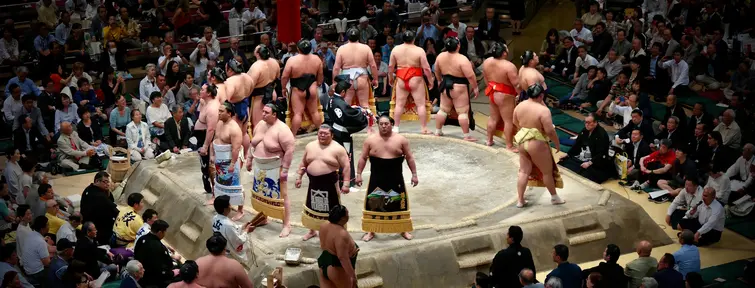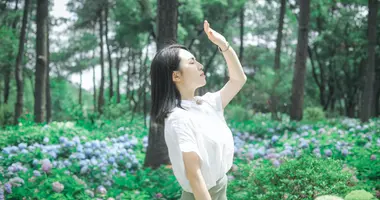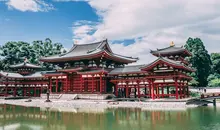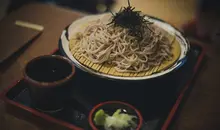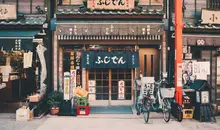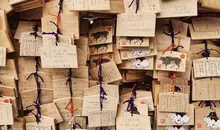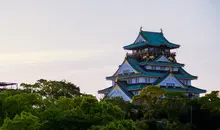Sumo: Japanese wrestling
- Published on : 20/04/2020
- by : C.W.
- Youtube
The weight of the sky
Sumo, Japan's emblematic martial art, is much more than a simple combat sport. A true religious, historical and popular monument, it embodies the very soul of Japanese culture through its millennia-old rituals and mastered raw power. In the arena, two colossal bodies clash for a few intense seconds, crystallizing ritualized violence in the extreme. This ancestral form of wrestling, which first appeared around 1500 years ago, continues to fascinate as much for its spiritual dimension as for the impressive size of its practitioners.
The mythological and historical origins of sumo
The roots of sumo go deep into Japanese mythology. The first written trace of this discipline dates back to 712 A.D. in the Kojiki, one of the oldest Japanese texts, which recounts the battle between two deities: Takemikazuchi, the god of thunder, and Takeminakata, the god of wind. This mythical duel is said to have determined the possession of the Japanese islands, enabling the people led by Takemikazuchi to establish themselves on the archipelago and found the imperial family from which the current emperor descends.
Another founding text, the Nihon Shoki (720), mentions the battle between Nomi-no-Sukune and Taima-no-Kuehaya during the reign of Emperor Suinin. Victorious, Nomi-no-Sukune is today revered as the "father of sumo" and considered the patron saint of wrestlers, with a dedicated shrine in Tokyo's Ryōgoku district.
Beyond these legendary accounts, historians believe that sumo wrestling first appeared around 1500 years ago, initially as Shinto religious rituals. These confrontations, accompanied by dance and drama, were dedicated to the kami (deities) to obtain their benevolence and guarantee good harvests. Sumo was then an agrarian ritual before becoming a global rite for peace and prosperity.
In the 8th century, during the Nara period, sumo became part of imperial court ceremonies under the name of sechie-zumo. Annual tournaments were organized, accompanied by music and dance. At the time, fighting was a mixture of boxing and wrestling, with almost any blow allowed, far from the codified form we know today.
The fundamental characteristics of sumo fighting
Sumo fighting is characterized by its apparent simplicity and profound technicality. The objective is clear: to get the opponent to leave the sacred circle (dohyō) or to touch the ground with a part of the body other than the soles of the feet. Yet this apparent simplicity conceals an impressive wealth of technique.
The dohyō, the central element of the fight, is a square platform made of packed clay, raised from 34 to 60 cm. At the center is a 4.55-meter-diameter circle delimited by straw bales anchored to the platform. The circle symbolizes the sky, while the surrounding rope represents the earth. Above the arena stands a suspended shinmei-zukuri roof, similar to that found in Shinto shrines, transforming the fighting space into a truly sacred place.
The wrestlers, known as rikishi (literally "strong men"), wear only a mawashi, a tight band of cloth around the waist and crotch that can be up to 14 meters long, depending on the fighter's build. This mawashi is the only solid hold permitted during the fight. Wrestlers in the higher divisions wear a silk mawashi, while those in the lower divisions make do with a cotton mawashi.
Unlike many combat sports, sumo has no weight categories. A rikishi can face an opponent weighing twice his own weight. However, wrestlers in the top divisions generally weigh around 150 kg, an ideal balance between stability and agility.
The fight itself begins with a series of complex preparatory rituals. After being called by the yobidashi (announcer), the wrestlers climb onto the dohyō and perform the shiko, powerfully striking the ground with their feet to chase away evil spirits. They then throw salt on the arena (kiyome no shio) to purify it and drink "strength water" (chikara-mizu), which they then spit out.
The fight begins at the signal of the gyōji (referee), who presents his fan. The wrestlers must first touch the ground with both fists to accept the confrontation, then lunge towards each other in what is known as the tachi-ai. This first contact, the atari, is often impressively violent. Rikishi may use 82 official holds (kimarite) to defeat their opponents, but certain gestures such as pulling hair, striking with a closed fist or strangling are strictly forbidden.
Daily life and rikishi training
A rikishi's life is entirely dedicated to his art, and follows an immutable rhythm dictated by iron discipline. Young wrestlers generally join sumo stables, or "heya", at around the age of 15. These establishments serve as training grounds, dormitories and permanent residences for sumotori.
The day begins very early, usually around 5:30 or 6 am. The wrestlers get up and immediately begin their keiko, the morning training session, always on an empty stomach to stimulate the appetite. Before they even begin physical exercise, they have to clean the dormitories, sweep and rake the training arena floor meticulously.
Training begins with rigorous stretching, performed in groups and in rhythm with millimetric precision. Although the imposing stature of the rikishi may suggest otherwise, sumo is first and foremost a technical discipline requiring flexibility and agility. Wrestlers practice daily to master the 82 different holds that make up sumo's technical arsenal.
After several hours of intensive training, it's time for the first meal, usually around midday. The main course is chanko nabe, an extremely high-protein stew specially designed for sumotori. This dish, accompanied by an impressive quantity of rice and often beer, provides the calories needed to put on weight - rikishi ingest an average of 5,000 to 8,000 kcal per day. After this copious meal, a siesta is essential to promote nutrient assimilation and weight gain.
There's a strict hierarchy in the stable. The youngest serve and assist the eldest, preparing the chanko nabe, cooking the rice and taking care of all domestic chores. This hierarchical structure is fundamental to learning sumo's values of respect and humility.
Although the aim is to gain weight,intense training enables rikishi to develop considerable muscle mass beneath their layer of fat. Contrary to popular belief, active sumotoris are generally in good health despite their apparent overweight, as their fat is mainly subcutaneous and not visceral. It's often in retirement, around the age of 30, that health problems can arise if diet is not adapted and physical activity maintained.
Watch Sumo training in Japan
Hierarchies and tournaments in the sumo world
The sumo world is structured by a complex and rigorous hierarchy that determines the status of each wrestler. There are around 600 wrestlers in professional sumo, divided into six distinct divisions, from highest to lowest: Makuuchi, Jūryō, Makushita, Sandanme, Jonidan and Jonokuchi.
The Makuuchi division, sumo's elite, comprises 42 wrestlers divided into five ranks: Yokozuna (grand champion), Ōzeki (champion), Sekiwake, Komusubi and Maegashira. The Yokozuna title is the most prestigious and is only awarded to wrestlers who have demonstrated consistent excellence - usually after winning at least two major tournaments consecutively - and whose moral dignity is beyond reproach. Unlike the other ranks, the Yokozuna title is retained for life, although a wrestler is required to retire if he can no longer maintain performances worthy of his status.
The 70 wrestlers in the Makuuchi and Jūryō divisions are collectively known as sekitori and are the only ones to receive a salary from the Japanese sumo association. Within each category, ranks are further subdivided into East and West, with the East position being slightly more honorific.
The ranking, or banzuke, is published around two weeks before each tournament and determines the opponents each wrestler will face. After each tournament, the ranking changes according to the results obtained: a wrestler who has won more fights than he has lost (kachi-koshi) will see his rank improve, while a negative record (make-koshi) will lead to demotion.
The annual professional sumo calendar is structured around six major tournaments called hon-basho, each lasting 15 days:
- Hatsu basho in Tokyo in January
- Haru basho in Osaka in March
- Natsu basho in Tokyo in May
- Nagoya basho in Nagoya in July
- Aki basho in Tokyo in September
- Fukuoka Sumo Tournament (November) in Fukuoka
During these tournaments, the sekitori compete in 15 bouts, one per day, while the lower-division wrestlers compete in just seven. The wrestler with the most victories in his division receives the yūshō trophy. In the Makuuchi division, other distinctions may be awarded, such as kinboshi (gold stars) for a maegashira who beats a yokozuna, or the three special prizes (sanshō): the prize for technique (ginō-shō), outstanding performance (shukun-shō) and fighting (kantō-shō).
Between official tournaments, regional tours (jungyō) are organized across Japan and sometimes abroad, enabling the public to attend sumo demonstrations in a more informal setting and meet the wrestlers.
Reserve your tickets for the Fukuoka sumo tournament!
Rituals and ceremonies surrounding the fights
Sumo is distinguished by the wealth of rituals and ceremonies that surround each bout, bearing witness to its Shinto religious origins. Far from being mere folk traditions, these ancestral practices are the very essence of this sacred sport.
The tournament day begins with the ring-entry ceremony, or dohyō-iri. Wrestlers in the Makuuchi division, dressed in their keshō-mawashi (richly ornamented ceremonial apron), parade around the dohyō in order of rank. They then perform a collective ritual in which they clap to attract the attention of the gods, raise their arms as a sign of respect and lift their ceremonial aprons slightly to show that they are not concealing weapons.
Yokozuna have a special, more solemn entrance ceremony. Accompanied by an assistant (tsuyuharai) and a sword bearer (tachimochi), they wear a sacred white rope (shimenawa) around their waist, similar to that which delimits the sacred spaces in Shinto shrines. They then perform a series of ritual gestures in one of two traditional styles: unryū (where the left arm is stretched forward) or shiranui (where both arms are extended).
Before each bout, wrestlers perform purification rituals. They rinse their mouths with sacred water (chikara-mizu) to purify their bodies and minds. They then throw handfuls of salt onto the arena (kiyome no shio) to purify it and ward off evil spirits. Salt is a fundamental purifying element in Shintoism.
The fight preparation phase, known as shikiri, is meticulously codified. Wrestlers crouch face to face, clap their hands to attract the attention of the gods (kashiwade), then stretch out their arms to show that they have no weapons (chiri-chōzu). They may repeat these gestures several times, in a kind of psychological warfare to impress the opponent, before simultaneously touching the ground with both fists, signaling their agreement to begin combat.
The duration of shikiri is strictly regulated: 4 minutes for the Makuuchi division, 3 minutes for the Jūryō division and 2 minutes for the lower divisions. In the past, this phase could last over an hour, but was gradually shortened to accommodate the constraints of radio and then television broadcasting.
At the end of each tournament day is the bow ceremony (yumitori-shiki), during which a wrestler from the Makushita division performs a ritual dance with a bow. This tradition dates back to the days when archers demonstrated their skills before the shogun after sumo fights.
These rituals, handed down from generation to generation, help to make sumo more than just a sport - it's a true religious ceremony that keeps millennia-old traditions alive and honors the gods who watch over Japan.
Modern sumo: between tradition and evolution
Contemporary sumo stands at a fascinating crossroads between preserving ancestral traditions and adapting to the realities of the modern world. An emblematic Japanese sport, it faces many challenges in maintaining its relevance while preserving its unique cultural essence.
One of the most notable changes in modern sumo is theincreasing internationalization of its practitioners. Since the 1960s, there has been a growing presence of foreign wrestlers in the professional ranks, first with Hawaiians and Polynesian Americans, then, from the 1990s onwards, with the massive arrival of Mongolian wrestlers. Today, the latter dominate the sumo elite, as witnessed by the exceptional careers of Asashōryū, Hakuhō, Harumafuji or Kakuryū. Other nationalities have also made their mark, including Bulgarian, Estonian, Georgian and even Egyptian wrestlers.
This globalization has provoked contrasting reactions in Japan. Some see it as a threat to sumo's cultural identity, leading the Japan Sumo Association to introduce quotas limiting the number of foreign wrestlers per stable to one in 2002. For others, this openness testifies to sumo's universal greatness and its ability to transcend cultural boundaries.
At the same time, sumo is facing a vocational crisis among young Japanese. The number of national candidates is declining year on year, to the extent that in 2007, selection tests had to be cancelled for lack of participants. This lack of interest is due to the acknowledged hardship of rikishi life, the limited career prospects for those who don't reach the elite, and competition from other sports such as baseball and soccer, which are more popular with Japanese youth.
Sumo has also been rocked by several scandals in recent decades, which have tarnished its image as a noble and virtuous sport. Cases of mistreatment of young apprentices, culminating in the tragic death of a young wrestler in 2007, have revealed the problematic aspects of the traditional apprenticeship system. Cases of drug use, illegal betting and even match-fixing have also plagued the discipline, leading to the unprecedented cancellation of the March 2011 tournament, the first since 1946.
In the face of these challenges, the Japanese Sumo Association is striving to modernize certain aspects of the discipline while preserving its fundamental values. Training conditions have been improved to reduce abuse, and efforts are being made to make sumo more accessible and attractive to contemporary audiences, notably through international promotional tours and the use of social networks.
The place of women in sumo remains a controversial issue. According to a traditional interpretation of Shintoism, women are not allowed on the dohyō, considered a sacred space which they would "defile" by their presence. This exclusion, which sometimes extends to the impossibility of women coming to the aid of a man who is unwell in the arena, is the subject of growing debate in modern Japanese society. At the same time, women's amateur sumo has been developing, with international competitions organized since the 1990s.
Despite these developments and tensions, sumo continues to capture the collective imagination, both in Japan and internationally. Its unique ability to combine brute force and ritual elegance, age-old tradition and contemporary spectacle, makes it a living testimony to Japan's cultural richness and its ability to adapt to global change.
How to attend a sumo tournament in Japan
Attending a sumo tournament during a trip to Japan is an unforgettable cultural experience, allowing you to immerse yourself in an ancestral tradition that is still very much alive. Here's how to make the most of this unique adventure.
As previously mentioned, the professional sumo calendar is structured around six major annual tournaments (hon-basho), each lasting 15 days: three in Tokyo (January, May and September), one in Osaka (March), one in Nagoya (July) and one at the Fukuoka Sumo Tournament (November). To maximize your chances of attending a tournament, it's a good idea to plan your trip around these dates.
In Tokyo, tournaments are held at the Kokugikan, located in the Ryōgoku district, the epicenter of the sumo world. This 11,000-seat indoor stadium, recognizable by its Shinto temple-style roof, also houses a museum dedicated to sumo, accessible free of charge outside tournament periods.
To book your tickets, you have several options. The easiest is to buy your tickets online from the Japan Sumo Association's official website around a month before the tournament begins. Tickets generally go very quickly, so be careful about when they go on sale. You can also book through specialized travel agencies or high-end hotels, which sometimes offer packages that include tickets.
If you haven't been able to book in advance, a limited number of tickets (around 400) go on sale each morning of the tournament directly from the stadium box office, from 7.45am. To maximize your chances, it's advisable to arrive early, before 6:00 a.m., as queues form quickly. These seats are usually located at the very top of the stadium, but remain an excellent last-minute option.
Several types of seats are available, at varying prices:
- Floor seats (tamari-seki), closest to the action, are the most prestigious but also the hardest to get.
- Traditional boxes (masu-seki), square spaces for 4 where you sit on cushions, offer an authentic experience.
- The more conventional tiered seats (arena-seki) are classified into categories A, B and C according to their proximity to the ring.
Prices vary considerably, from 2,200 yen (approx. €17) for the cheapest seats to over 14,800 yen (approx. €115) for the best.
A tournament day starts early, at around 8:30 a.m., but wrestling in the higher divisions doesn't begin until the early afternoon. The yokozuna bouts generally take place at the end of the day, around 5:00 pm. To get the full experience, plan to arrive at least for the Makuuchi division' s entrance parade , at around 3:30 p.m., an impressive visual spectacle with sumotoris in full regalia.
If you can't attend a tournament, there are other options for discovering the world of sumo. For example, you can attend a morning training session at one of Tokyo's stables. These sessions, known as asageiko, start very early (usually around 6:00 a.m.) and allow you to observe the rikishi practicing in their everyday environment.Early morning sumo training is a fascinating experience, but one that demands respect and discretion. Some stables accept visitors without reservation, while others require an introduction by a Japanese person or booking through a hotel.
Tokyo's Ryōgoku district is also worth a visit to soak up the sumo atmosphere. Here you'll find restaurants specializing in chanko nabe, the traditional wrestlers' stew, often run by former rikishi. It's also an opportunity to discover other Tokyo activities linked to traditional Japanese culture.
Whether you attend a major tournament or a simple training session, the world of sumo offers a fascinating insight into Japanese culture, combining physical strength, age-old tradition and Shinto spirituality. An experience comparable to that of Patricia Loison in sumo land, as memorable as that of Yabusame, traditional Japanese archery, and one that will remain engraved in your memory long after your return.
